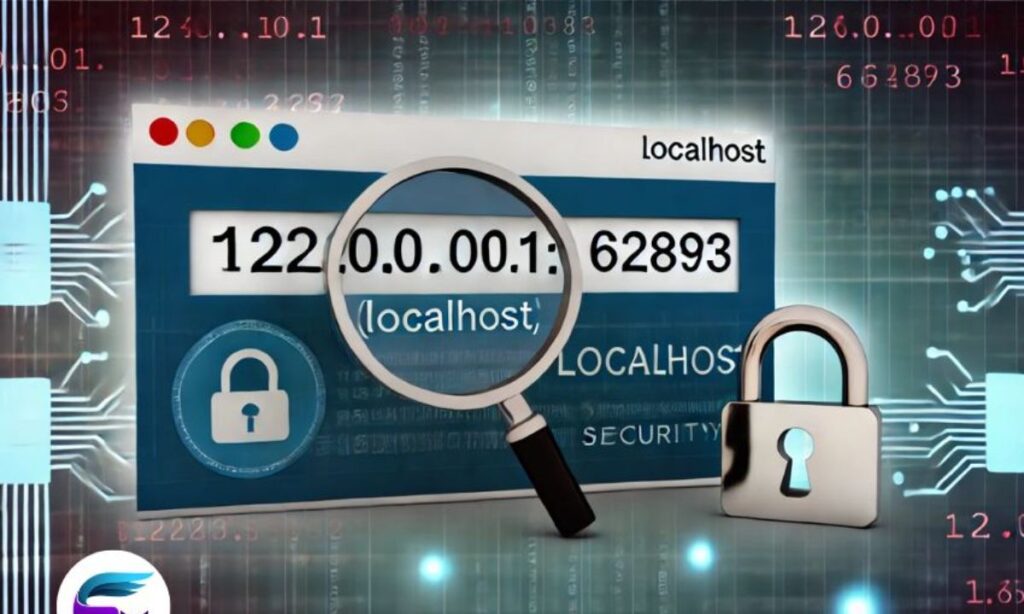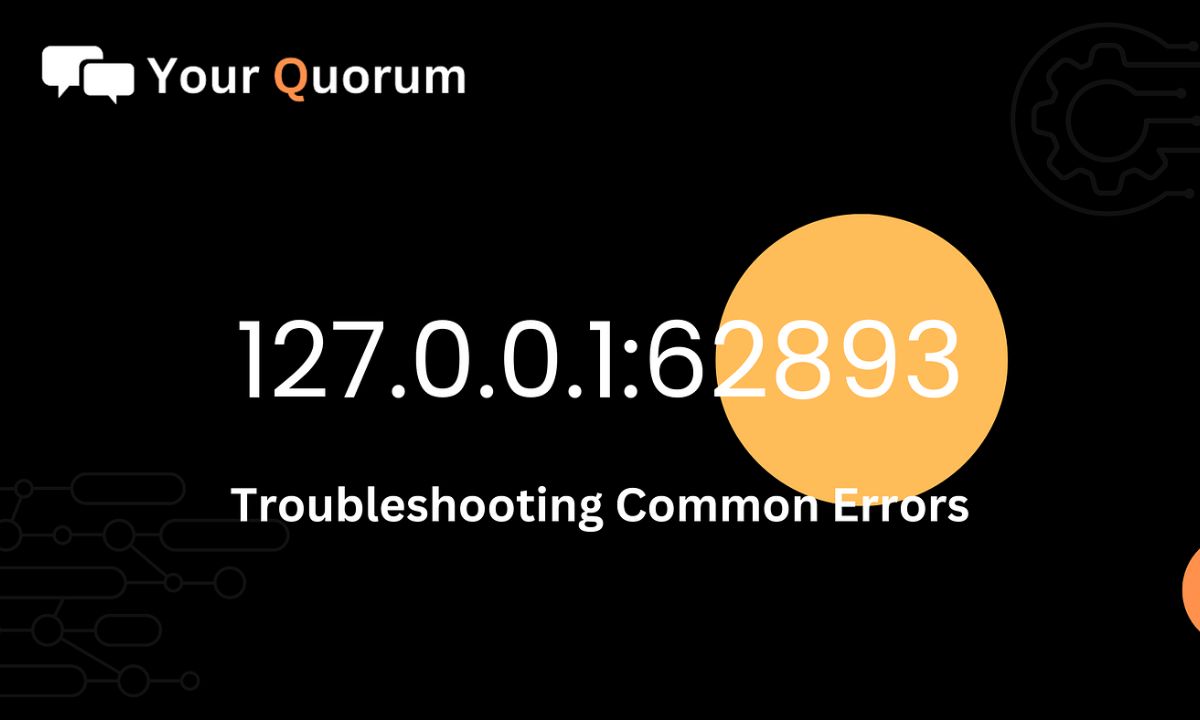What is 127.0.0.1:62893?
The IP address 127.0.0.1 is known as the localhost. It allows your computer to communicate with itself. The port 62893 is a specific gateway for network traffic. Together, they create a local testing environment. This setup is crucial for developers and IT professionals.
Using 127.0.0.1:62893 helps in testing applications without exposing them to the internet. This isolation is beneficial for debugging and development. It ensures that any errors or issues remain contained within the local environment.
Understanding this combination is vital. It helps in effective network management. Developers can identify issues more quickly. They can also ensure their applications work as intended before going live.
How Does the Loopback Address 127.0.0.1 Work?
The loopback address functions as a closed network. Any data sent to 127.0.0.1 stays within your device. This means that it does not reach the external network. It allows for efficient testing.
When you access 127.0.0.1, you are telling your computer to process the request internally. This process is essential for testing services like web servers and APIs. It ensures that developers can evaluate their work safely.
Using the loopback address minimizes risks. It keeps data secure and private. Furthermore, it allows for quick feedback during development. Developers can run multiple tests without affecting external services.
What are the Benefits of 127.0.0.1:62893?
There are numerous benefits to using 127.0.0.1:62893. For starters, it provides a safe testing environment. Developers can experiment without fear of external exposure. This isolation is critical for maintaining security.
Another benefit is the efficiency of local testing and development. Developers can quickly test their applications. They do not need to deploy them on a live server. This speeds up the development process considerably.
Additionally, using 127.0.0.1:62893 allows for easy debugging. Since all traffic is local, developers can isolate issues more effectively. This leads to faster problem resolution. Overall, this configuration enhances productivity and security.
How Efficient is Local Testing and Development?
Local testing is incredibly efficient. Developers can make changes and see results immediately. There is no need to wait for deployment or external server responses. This immediacy allows for rapid iterations.
Moreover, local environments reduce the risk of errors. Developers can catch problems before they reach production. This leads to higher quality applications. It also minimizes downtime and user disruptions.
Using 127.0.0.1:62893 is a cornerstone of modern development practices. It supports agile methodologies. Teams can respond quickly to changes. This adaptability is crucial in today’s fast-paced tech landscape.
Enhanced Security in Development Environments

Using localhost significantly enhances security. When developers work in a local environment, they reduce exposure to threats. External attacks are less likely to affect applications running on 127.0.0.1.
This isolation allows developers to focus on building secure applications. They can test security features without worrying about internet vulnerabilities. It also means sensitive data stays within the local network.
Furthermore, developers can configure firewall settings to protect their local environment. They can restrict access to 127.0.0.1 while allowing necessary traffic. This balance ensures a secure testing ground for all applications.
How 127.0.0.1:62893 Works?
The combination of 127.0.0.1 and port 62893 allows for seamless communication. When a request is sent to this address, it directs traffic to the intended service. This setup is essential for local applications.
Understanding how this works helps in troubleshooting. If there are issues, developers can identify whether it’s an application problem or a configuration issue. This knowledge is invaluable for maintaining operational efficiency.
The role of the loopback address is fundamentally about internal communication. It simplifies testing by keeping everything local. This leads to better performance and reliability in applications.
The Role of IP Address 127.0.0.1 in Networking
127.0.0.1 serves a critical role in networking. It allows devices to communicate internally. This is particularly useful for testing and development. By using this address, developers can simulate network conditions.
This capability is essential for ensuring applications function correctly. It allows for comprehensive testing without external dependencies. Developers can verify the performance and security of their code.
In networking, 127.0.0.1 is a standard reference point. It is universally recognized across different operating systems. This consistency makes it a reliable tool for developers and system administrators.
Understanding Port 62893
Port 62893 is categorized as an ephemeral port. This means it’s used temporarily for specific sessions. It is not a well-known port like HTTP or FTP. Instead, it serves applications that require dynamic connections.
Understanding how port 62893 functions is crucial. It helps in managing local applications effectively. Developers can configure their applications to use this port for various tasks.
Using port 62893 allows for flexibility. Developers can run multiple services simultaneously. Each service can operate without interference. This organization is vital for efficient local development.
Read This Blog Also : Understanding the NSCocoaErrorDomain Error
Why Use 127.0.0.1:62893 in Network Configurations?
Using 127.0.0.1:62893 in network configurations offers numerous advantages. It creates a dedicated space for local applications. This ensures that traffic routes correctly within the local machine.
This configuration is particularly useful for application testing and debugging. Developers can isolate issues and ensure functionality. They do not need to worry about external factors affecting their tests.
Moreover, 127.0.0.1:62893 simplifies development workflows. Developers can set up their environments quickly. They can focus on building and testing instead of configuring external connections.
Common Use Cases for 127.0.0.1:62893
There are many common use cases for 127.0.0.1:62893. One primary use is in web development. Developers can run local servers on this port to test applications.
Another common scenario is API testing. Developers can verify API responses without affecting live environments. This allows for thorough testing before public release.
Additionally, 127.0.0.1:62893 is often used for debugging. Developers can track issues in real-time. This capability leads to quicker resolutions and better application stability.
How to Configure 127.0.0.1:62893 for Development

Configuring 127.0.0.1:62893 for development is straightforward. First, ensure that the application is set to run on this port. This can usually be done in the application’s settings.
Next, check your firewall settings. Make sure that traffic to port 62893 is allowed. This step is crucial for ensuring proper connectivity.
Finally, test the configuration. Access 127.0.0.1:62893 from a browser or network tool. This will confirm that the setup is functioning correctly and ready for use.
Is it Safe to Use 127.0.0.1:62893?
Yes, using 127.0.0.1:62893 is generally safe. Since it operates within a local environment, it is less exposed to external threats. This isolation provides a secure space for development.
However, developers should still implement security measures. Regularly monitor applications for vulnerabilities. Ensure that configurations do not expose sensitive data.
Maintaining vigilance is essential for security. Even in a localhost environment, potential risks may arise. Taking proactive steps can help mitigate these risks.
Security of Using Localhost 127.0.0.1
The security of using localhost 127.0.0.1 is a significant advantage. It keeps all traffic internal. This means that sensitive data is less likely to be intercepted. Developers can focus on building secure applications.
Additionally, using localhost allows for controlled testing environments. Developers can assess security features without external interference. This capability is crucial for ensuring robust application security.
Minimizing Risks When Using Port 62893
To minimize risks when using port 62893, follow best practices. Regularly monitor applications for unusual activity. Ensure that users have appropriate access levels.
It is also essential to configure firewalls correctly. Restrict external access while allowing necessary internal traffic. This balance will help maintain a secure environment.
Lastly, keep software and dependencies updated. Outdated applications can introduce vulnerabilities. Regular updates ensure that security measures remain effective.
What are the Common Errors with 127.0.0.1:62893?
When using 127.0.0.1:62893, several common errors may occur. One frequent issue is the Connection Refused error. This happens when the service is not running or is blocked by a firewall.
Another common error is the 404 Page Not Found error. This occurs when the requested resource does not exist. It indicates a configuration issue or a missing file.
Additionally, users may encounter Access Denied errors. These result from incorrect permissions. It is essential to adjust settings to allow proper access.
What Causes 127.0.0.1:62893 Connection Issues?
Connection issues with 127.0.0.1:62893 can stem from several factors. Port conflicts are a common cause. If another application uses the same port, it can lead to errors.
Firewall settings may also block access. If the firewall is not configured correctly, it can restrict local traffic. This will prevent successful connections.
Misconfigured network settings can further complicate matters. If the localhost is not set up correctly, it can lead to connection failures. Regular checks can help identify these issues early.
How to Identify Port 62893 Errors?
To identify errors on port 62893, use various tools. The netstat command helps check active connections. This tool will show which ports are in use and by which processes.
On Unix-based systems, the lsof command provides detailed information. It helps identify processes using specific ports. This can be invaluable for troubleshooting.
Additionally, network analyzers can capture and inspect traffic. This helps diagnose issues related to port connectivity. By using these tools, developers can quickly identify and resolve errors.
How to Setup 127.0.0.1:62893?
Setting up 127.0.0.1:62893 is a straightforward process. First, ensure that the application is configured to run on this port. Check the application settings for correct port assignment.
Next, verify that firewall settings allow traffic through port 62893. Adjustments may be necessary to ensure connectivity.
Finally, test the setup by accessing 127.0.0.1:62893 through a web browser. Confirm that the application is running correctly. This ensures that the configuration is complete.
Step-by-Step Guide to Setting Up 127.0.0.1:62893
- Check Application Settings: Ensure the application is set to use port 62893.
- Verify Firewall Configuration: Make sure the firewall allows traffic through this port.
- Test Connectivity: Access 127.0.0.1:62893 using a browser or network tool.
- Monitor Logs: Check application logs for any errors during startup.
Configuring Port 62893 for Network Testing
Configuring port 62893 for network testing involves several steps. First, identify the application that will use this port. Ensure it is compatible with the local environment.
Next, set up the application to listen on port 62893. This may involve editing configuration files or settings within the application.
Finally, conduct tests to ensure that the setup functions as expected. Check for proper communication between components. This verification is crucial for successful network testing.
How to Fix Common 127.0.0.1:62893 Errors?
Fixing common errors related to 127.0.0.1:62893 requires a systematic approach. Start by identifying the specific error message. This will guide you to the appropriate troubleshooting steps.
If you encounter a Connection Refused error, check if the service is running. Restarting the service may resolve the issue.
For 404 errors, ensure that the resource is properly deployed. Verify that the application configuration correctly points to the resource.
If facing Access Denied errors, review permissions. Adjust access controls to allow users the necessary permissions. This will help resolve these common issues.
Troubleshooting Network Issues on 127.0.0.1
To troubleshoot network issues on 127.0.0.1, follow a structured approach. First, verify that the service is operational. Restart the application if necessary.
Next, check firewall settings. Ensure that local traffic is not being blocked. Adjust settings to allow access to port 62893.
Examine log files for detailed error messages. These logs can provide insight into underlying issues. Address any identified problems to restore proper functionality.
How to Resolve Port 62893 Conflicts?

Resolving conflicts on port 62893 involves a few steps. First, identify which application is using the port. Use the netstat or lsof command for this purpose.
Once you identify the conflicting application, you can either close it or change its port. This will free up port 62893 for your intended use.
Additionally, consider adjusting application settings to avoid future conflicts. Ensure that port assignments are unique across all services. This will minimize the risk of similar issues occurring again.
How Can I Prevent Future Issues with 127.0.0.1:62893?
To prevent future issues with 127.0.0.1:62893, follow best practices. Regularly monitor port usage to avoid conflicts. Keeping track of which applications use specific ports is essential.
Maintain updated firewall settings. Ensure that internal traffic is allowed while restricting unnecessary access. Regular reviews will help keep your environment secure.
Finally, document configurations and changes. This will provide a reference for troubleshooting. Having a clear record can expedite issue resolution.
What are the Best Practices for Configuring Localhost and Ports?
Best practices for configuring localhost and ports include several key strategies. First, ensure that each application uses a unique port. This will help prevent conflicts and connectivity issues.
Second, regularly update firewall settings. Make sure that necessary ports are open for local traffic. This will enhance both functionality and security.
Lastly, monitor applications for unusual activity. Keeping an eye on performance can help identify potential issues before they escalate. Proactive management is essential for maintaining a smooth development environment.
Using Monitoring Tools to Maintain Localhost Stability
Monitoring tools are invaluable for maintaining localhost stability. Tools like Wireshark can analyze network traffic. This helps identify bottlenecks and performance issues.
Additionally, using netstat or lsof can help track port usage. This ensures that developers are aware of which applications are active at any given time.
Regular audits of local services can also help maintain stability. By proactively identifying vulnerabilities, developers can ensure a secure and efficient development environment.
Conclusion
Understanding 127.0.0.1:62893 is vital for effective network management. This combination of localhost and port offers numerous benefits for developers. It enables efficient testing, enhances security, and simplifies debugging.
By leveraging this configuration, developers can create robust applications. They can troubleshoot issues quickly and maintain secure environments. As technology evolves, mastering 127.0.0.1:62893 will remain crucial for successful software development.
FAQs
What is 127.0.0.1?
127.0.0.1 is the loopback address, used for internal network testing.
What is the significance of port 62893?
Port 62893 is often used for local testing and development.
Why is localhost important for developers?
Localhost allows developers to test applications securely without external exposure.
What does the “Connection Refused” error mean?
This error indicates the service is not running or a firewall is blocking access.
How can I resolve a “Page Not Found” error?
Ensure the resource exists on the server and is properly configured.

Sahar is a talented content writer and digital marketer with expertise in SEO, social media management, and online marketing. She excels at creating impactful, data-driven content to help businesses connect with their target audience and achieve measurable outcomes.





